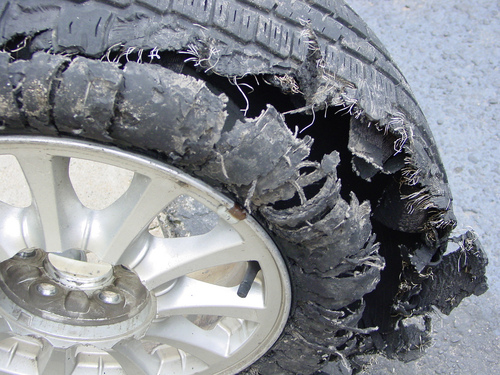Your car’s tires are among the most expensive vehicle-maintenance items you’ll have to cover. Tires are also among the most important safety features.
Most of us would never dream of sliding behind the wheel without buckling our seat belts. And in many cases, people make buying decisions based on the availability of front- and side-impact airbags. So why wouldn’t you take every precaution necessary to ensure your tires – the very things that keep you on the road – aren’t in tip-top condition? Tires are what make for a ‘connected car,’ and we mean that in the traditional sense! Traction, performance in poor weather, and being able to stop on a dime are all dependent on good tires.
Here’s a list of 5 facts you probably didn’t know about your tires. Knowing them and adhering to them could be the difference between arriving at your destination safe and sound, or spending the night waiting for a tow truck to pull you out of a ditch.
1) The leading cause of tires blowing out while you’re driving is under-inflation.
Tires are tough and can take a lot of abuse, but when you drive on a tire that’s got too little air in it, this can have serious and potentially life-threatening implications. When your tires are under-inflated, the sidewalls become weak. The integrity of your tire’s sidewalls is critical, and driving on under-inflated tires can put you and your car in serious jeopardy. These days, many cars have tire-pressure monitoring systems. And compressed air is free at many gas stations. So you’ve got no excuse to pump up.
2) Another leading cause of tire failure is over-inflation.
Think of your tires as big, strong, rubber balloons. If you pump too much air into them, they run the risk of popping. When a tire pops, however, it’s more like a mini explosion that can have grave consequences if you blow a tire while driving, especially at high speeds. Pumping too much air into your tires can cause premature wear, and can even damage your car’s suspension.
3) Appearances can be deceiving.
Sometimes it’s impossible to tell, just by looking at a tire, if it’s got too much air or too little air. For this reason, swinging by a gas station and pumping air into your tires is ill-advised unless the air compressor you’re using has a built-in pressure gauge. To be on the safe side, get your hands on a tire pressure gauge, which may run you about $2.00, and keep it in your glove compartment. By having one on hand, you’ll be prepared in the event the gas station air pump doesn’t have a gauge, or if the gauge gives you a false reading. Every time you fill your tires with air, double check the pressure with your own gauge.
4) How a tire wears may indicate a larger issue.
If your see that your car’s front tires are wearing unevenly, this could indicate that your wheel alignment is out of whack. To save yourself the money you might otherwise spend to replace tires that have worn unevenly, have your alignment checked once a year at your local auto repair service center. And if you live and drive in a city environment and are subject to riding over pot-holes, you may want to have your alignment checked more than once a year.
5) Mini-spares should only be used to get you from point A to point B.
Never leave a mini-spare on your car any longer than is absolutely necessary; they aren’t built for long-distance travel. Most importantly, it’s unsafe to drive on a mini-spare any faster than 50 miles per hour. If you do, you run the risk of having the spare blow out or losing control of your car, since the safe motion of your car is greatly dependent on tires with matching tread widths.
Want more info on tires?
Be on the safe side and check the air pressure of your tires at least once per month. Before heading out on a road trip, always give your tires a once-over. If one of them looks significantly lower than the rest, this is clear indication that you’ve got a slow leak that should be taken care of immediately. Always refer to your owner’s manual for the proper air pressure guidelines, and never inflate a tire past the maximum capacity indicated on the sidewall of the tire itself. And drive safely!
Vehicle maintenance and repair can be a pain. Anytime you’re feeling less DIY and more DIFM (do-it-for-me), try Openbay. Compare pricing and book service from quality local shops with the click of a button. Openbay is car repair for today’s world.
Save upwards of 25% on
car repair and maintenance services with Openbay+

